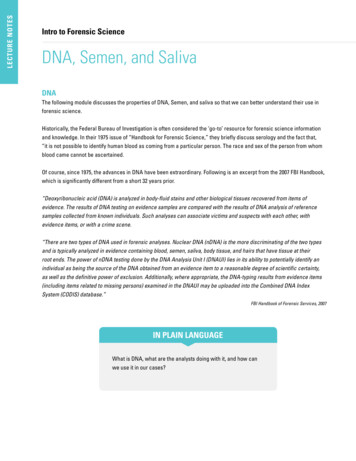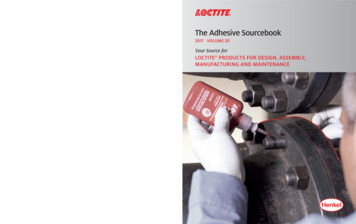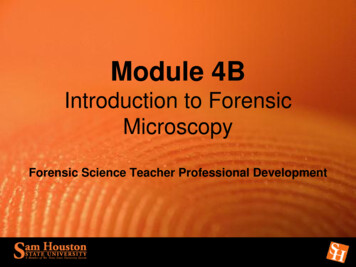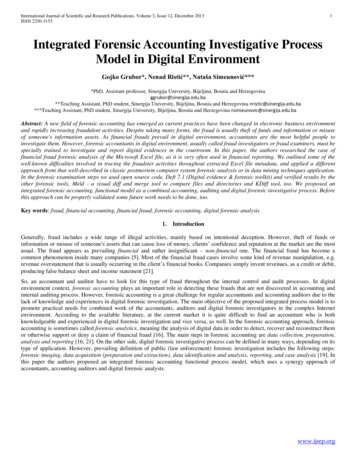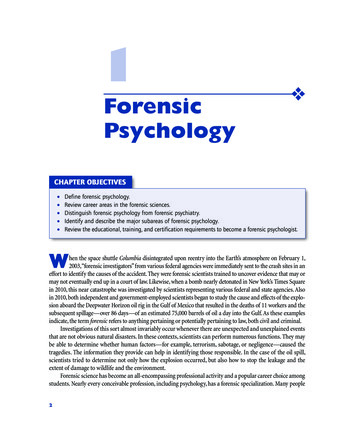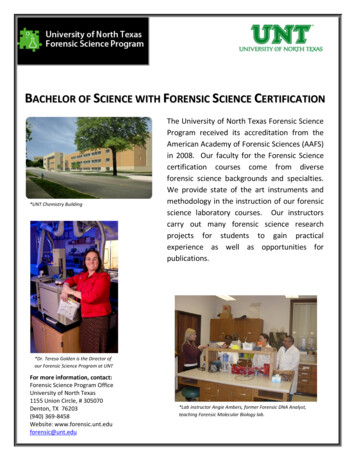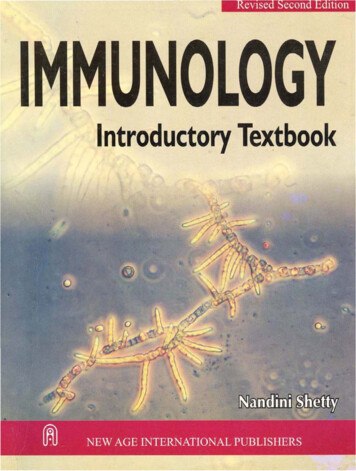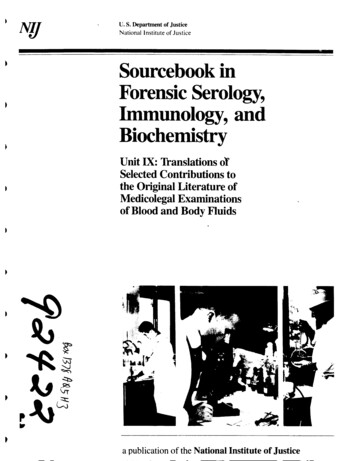
Transcription
U. S. Department of JusticeNational Institute of JusticeSourcebook inForensic Serology,Immunology, andBiochemistryUnit M:Banslations ofSelected Contributions tothe Original Literature ofMedicolegal Examinationsof Blood and Body Fluids-a publication of the National Institute of Justice
About the National Institute of JusticeT h e National lnstitute of Justice is a research branch of the U.S. Department of Justice. T h e Institute'smission is to develop knowledge a b o u t crime. its causes and control. Priority is given t o policy-relevantresearch that can yield approaches and information State and local agencies can use in preventing andreducing crime. Established in 1979 by the Justice System Improvement Act. NIJ builds u p o n the foundationlaid by the former National lnstitute of Law Enforcement and Criminal Justice. the first major Federalresearch program on crime and justice.Carrying out the mandate assigned by Congress. the National lnstitute of Justice:Sponsors research and development t o improve a n d strengthen the criminal justice system a n d relatedcivil justice aspects, with a balanced program of basic and applied research.Evaluates the effectiveness of federally funded justice improvement programs a n d identifies programsthat promise to be successful if continued o r repeated.Tests and demonstrates new and improved approaches to strengthen the justice system, and recommendsactions that can be taken by Federal. State. a n d local governments a n d private organbations andindividuals to achieve this goal.Disseminates information from research. demonstrations, evaluations. and special prograrris t o Federal.State. and local governments: and serves a s a n international clearinghouse of justice information.Trains criminal justice practitioners in research a n d evaluation findings. and assists the research c o m m u n ity through fellowships and special seminars.Authorit) for administering the lnstitute a n d awarding grants. contracts. a n d cooperative agreements is\ested in the NlJ Director. An Advisory Board. appointed by the President. assists the Director by recomm e n d n gpolicies and priorities and advising o n peer review procedures.Reports of NIJ-sponsored studies are reviewed hy lnstitute officials and staff. T h e views of outside expertsknowledgeable in the report's subject area a r e also obtained. Publication indicates that the report meets theInstitute's standards of technical quality, but it signifies n o endorsement of conclusions o r recommendations.James K. StewartDirec.ror
U.S. Department of JusticeNational Institute of JusticeSourcebook inForensic Serology,Immunology, andBiochemistryUnit IX: Banslations ofSelected Contributions tothe Original Literature ofMedicolegal Examinationsof Blood and Body Fluidscompiled and edited b R.E. Gaensslen, Ph.D.Professor of Forensic ScienceUniversity of New HavenWest Haven, Connecticutwith aforeword byFrank R. Camp, Jr.Colonel, USA (Ret.)Scientific DirectorlDirecrorAmerican Red Cross Blood ServicesLouisville RegionLouisville, KentuckyAugust 1983
This project was supported by Grant Numbers 76-NI-99-0107and 78-N1-AX-0001, awarded to R.E. Gaensslen, Ph.D., by theNational Institute of Justice, U.S. Department of Justice, under theOmnibus Crime Control and Safe Streets Act of 1968, as amended.Points of view or opinions stated in this document are those of theauthors and do not necessarily represent the official position orpolicies of the U.S. Department of Justice. The mention ofmaterials or processes by generic name, trade name, or brand namein the text is for purposes of information only, and does notconstitute an endorsement or recommendation by the U.S.Department of Justice, the National Institute of Justice, or theauthor.The author reserves the right to reproduce, publish, translate, orotherwise use and to authorize others to publish and use all or anypart of the copyrighted material contained in this publication.Copyright @ 1983 by the Research Foundation of the CityUniversity of New York on behalf of R. E. Gaensslen.
On Semen and Seminal Stains in Legal Medicine.A. Florence (1895-1896). . . . . . . . . . . . . . . . . . . . . . . . . . . . . . . . . . . . . . . . . . . .104A New Micro-chemical Reaction of the Sperma and its Application inMedico-legal Investigations. M. Barberio (1905). . . . . . . . . . . . . . . . . . . . . . . .126On Forensic Identification of Semen and Semen Stains.Frank Lundquist (1945). . . . . . . . . . . . . . . . . . . . . . . . . . . . . . . . . . . . . . . . . . . .I 3 0SECTION 3. DETERMINATION O F SPECIES O F ORIGIN133Memoir on the Existence of a Principle Peculiar to Blood toCharacterize the Blood of Man and of Various Animal Species.J.P.Barruel(1829) . . . . . . . . . . . . . . . . . . . . . . . . . . . . . . . . . . . . . . . . . . . . . . .135.A New Way of Distinguishing Human Blood from that of Other Mammals.Casanti (1848). . . . . . . . . . . . . . . . . . . . . . . . . . . . . . . . . . . . . . . . . . . . . . . . . . . .138.On the Forensic Investigation of Dried Bloodstains.Rudolf Virchow ( 1857) . . . . . . . . . . . . . . . . . . . . . . . . . . . . . . . . . . . . . . . . . . . . .139Medico-legal Examination of Blood Stains. Z. Roussin (1865) . . . . . . . . . . . . . . . . I 4 1The Source of Blood in Legal Medicine. Charles Masson (1885) . . . . . . . . . . . . . I 4 7On the Possibility of Distinguishing Human Blood from that ofMammals. (Medico-legal Study) Ch. Vibert (1882) . . . . . . . . . . . . . . . . . . . . .159A Simple Method for the Forensic Differentiation of Human andMammalian Blood. H. Marx and E. Ehrnrooth (1904). . . . . . . . . . . . . . . . . . .163A New Contribution to the Specific Identification of Egg Protein Usingthe Biological Method. Paul Uhlenhuth (1900) . . . . . . . . . . . . . . . . . . . . . . . . I 6 7A Method for the Differentiation of Various Specific Blood Types,in particular for the Differential Diagnosis of Human Blood.Paul Uhlenhuth (1901) . . . . . . . . . . . . . . . . . . . . . . . . . . . . . . . . . . . . . . . . . . . . 1. 70Additional Reports on My Method for the Identification of Human Blood.Paul Uhlenhuth (1901) . . . . . . . . . . . . . . . . . . . . . . . . . . . . . . . . . . . . . . . . . . . . 172.Additional Reports on the Practical Application of My Forensic Method for theIdentification of Human and Animal Blood.Paul Uhlenhuth (1901) . . . . . . . . . . . . . . . . . . . . . . . . . . . . . . . . . . . . . . . . . . . . 1. 74Concerning My New Forensic Method to Identify Human Blood.Paul Uhlenhuth (1901) . . . . . . . . . . . . . . . . . . . . . . . . . . . . . . . . . . . . . . . . . . . .177.Concerning the Development of the Biological Method of ProteinDifferentiation in the Service of Legal Medicine with SpecialConsideration of Our Own Research Results. (Personal Recollections).PaulUhlenhuth(1949) . . . . . . . . . . . . . . . . . . . . . . . . . . . . . . . . . . . . . . . . . . . . 1. 79Concerning a New Forensic Method to Differentiate Human fromAnimal Blood. A. Wassermann and A. Schiitze (1901) . . . . . . . . . . . . . . . . . I 9 5A Process for the Forensic Identification of the Origin ofBlood (Fixation of Hemolytic Complement).M. Neisser and H. Sachs (1905) . . . . . . . . . . . . . . . . . . . . . . . . . . . . . . . . . . . . .198The Forensic Differentiation of Blood Using the Antihemolytic Effect(Second Communication) M. Neisser and H. Sachs (1906). . . . . . . . . . . . . .201SECTION 4. BLOOD GROUPING-MEDICO-LEGAL APPLICATIONS 205On the Practical Application of the Test for Agglutination for theSpecific and Individual Diagnosis of Human Blood.Leone Lattes (191 3 ) . . . . . . . . . . . . . . . . . . . . . . . . . . . . . . . . . . . . . . . . . . . . . . . .207Two Practical Cases of Individual Diagnosis of Human Blood.Leone Lattes(l916) . . . . . . . . . . . . . . . . . . . . . . . . . . . . . . . . . . . . . . . . . . . . . . . .213On the Technique of the Isoagglutination Test for the Individual Diagnosisof Blood. Leone Lattes (19 16) . . . . . . . . . . . . . . . . . . . . . . . . . . . . . . . . . . . . . .218.Practical Experience in Blood Group Determination in Stains.Leone Lattes (1 927). . . . . . . . . . . . . . . . . . . . . . . . . . . . . . . . . . . . . . . . . . . . . . . .222The Isoagglutinable Substance of Blood and its Demonstration forthe Individual Diagnosis of Stains. Vittorio Siracusa ( 1 923) . . . . . . . . . . . . . . 227
A Simple Procedure for the Determination of Groups in Dried Blood byAgglutinin Binding. Franz Josef Holzer (193 1) . . . . . . . . . . . . . . . . . . . . . . . . .237Investigations on the Medico-legal Usefulness of the Secretion ofBlood Group Substances. Franz Josef Holzer (1937) . . . . . . . . . . . . . . . . . . . 244The Current Status of Blood Group Serology and its Forensic Meaning.Franz Josef Holzer (1953). . . . . . . . . . . . . . . . . . . . . . . . . . . . . . . . . . . . . . . . .251iii
FOREWORDTranslations of Selected Contributions to the original Literature of Medicolegal Examinations of Blood and Body Fluids is Unit IX of a larger work with the title,Sourcebook in Forensic Serology, Immunology and Biochemistry.Unit IX contains 50 translated papers arranged in four sections. Section I, onIdentification of Blood, consists of 16 papers beginning with the early work of Orfila,using chemical means to identify blood, and differentiating rust, blood stains and stainsfrom lemon juice on iron in resolving the medical-legal matter of wounds. Themicroscope was found useful by Mandl, Robin and Salmon identifying the formedelements, red cells with and without a nucleus (human and certain species of animalblood) and differentiating menstrual blood from blood drawn from a vessel by notingthe mixture of blood cells with epithelial cells and leukocytes. In 1853, Teichmandescribed hemin crystals, a crystalline chloride of heme, which he obtained fromhuman blood and blood of the dog, rabbit, steer and other animals. Hoppe's 1862 papergives the early report on the behavior of hemoglobin in the spectrum of sunlight.In 1912, Takayama reported and expanded on the medicolegal applications ofhemochromogen crystals; Donogany described the production of hemochromogencrystals in 1893.In 1862, van Deen described the guaiacum test for detection of blood which wasreplaced with the more sensitive benzidine test reported by the Adlers in 1904. The lastpaper in Section I is the 1937 publication of Specht on the chemiluminescence ofhemin in detecting blood stains.Section 11, on Body Fluids has 10 papers, mainly dealing with the detection ofsemen by microscopy and stains, the crystal test of Florence and finally, Lundquist'sacid phosphatase test reported in 1945, which is useful in aspermic individual stains.Section 111, Determination of Species of Origin has 16 papers dealing with theapplications of immunology in forensic serology. Essentially, these were biologicalprotein differentiation and eventually, forensic blood differentiation reported byUhlenhuth, and Wassermann and Schiitze, within several weeks time, by use of theprecipitin test. Neisser and Sachs reported on the application of the complementfixation test as control and a supplement to the precipitin test.Section, IV, Blood Grouping-Medicolegal Applications has 8 papers. Notableare the papers of Leone Lattes in which he brought to the attention of the "forensiccamp" the Landsteiner rule sitting in the literature at that time for 12 years. Namely,that human bloods can be divided into four groups based on cells with or without Aand/or B antigen; and serum with or without anti-A and/or anti-B antibody. One candetermine this relationship from Landsteiner's study, but Lattes further explains thatthe division was expressed in this form only in the works of v. Dungern and Hirszfeld.Lattes also noted that the percentages of the single type (A-B-0 gene frequencies),quoted independently of one another, by v. Dungern and Hirszfeld in Heidelberg, andby Moss in Philadelphia, were just about identical. The figures showed that 40% of allbloods tested had no A or B antigens on the red cells, but did contain two agglutinins,alpha and beta in the serum. These bloods were called group 0 .In early articles, Lattes used the A-B-0 nomenclature of Landsteiner: AP, Ba,AB, and OaP but in the 1927 paper he used the Landsteiner and Jansky nomenclatures(classifications) together: Group 11 (AP), Group I (Oap). This is noted because duringthe 1930's the Moss, Jansky and Landsteiner classifications were used which resultedin some confusion to blood group serologists, physicians and blood bank personnel ingeneral. The situation was finally corrected when the a t i o n a lResearch Councilrecommended sole use of the Landsteiner classification to the Armed Services at the
beginning of World War I1 which was also the beginning of large scale bloodtransfusion.Siracusa reported (1923) on his absorption experiments with stains to identify thegroup by allowing the A and B antigens to absorb A and/or B agglutinin, respectively.He further confirmed the specificity of the absorption by eluting at 45OC and testingthe eluted agglutinins with A and B red cells.Franz Holzer was an internationally know forensic pathologist. His contributionsare well cited in the last three papers of Section 4. Holzer was one of Landsteiner's fivestudents. His passing, followed by that of Wiener, leaves only three remaining: PhilipLevine, Merrill W.'Chase, and J. L. Jacobs. In our lifetime, their contributions haveilluminated the scientific literature.Professor Gaensslen is to be commended for his scholarly achievement and contribution to the English literature in bringing together this extensive series of translations with direct bearing on forensic serology, immunology and biochemistry. Thetranslators, specialists, involved in this project have done an outstanding job.The late A. S. Wiener described P. B. Candela's efforts in identifying the bloodgroups of ancient bones (mummies) as a labor of love. Certainly the same can be saidof the Sourcebook and translation series which Professor Gaensslen and associateshave worked so diligently to bring to a successful completion. The translations andSourcebook will provide additional reference material for operational crime laboratories, academic institutions and research libraries. This availability to the workers,teachers, and research oriented staffs in the fields of forensic serology, immunologyand biochemistry provides a means to achieve new excellence in medicolegal studies.Frank R. Camp, Jr.Louisville, KentuckySeptember, 1978
PREFACEIn the course of preparing the Sourcebook in Forensic Serology, Zmmunology andBiochemistry, I became aware of set of translations of selected important papers inblood grouping and immunohematology. Selected and edited by Col. Frank R. Camp,Jr., Col. Frank R. Ellis and Col. Nicholas F. Conte at the Blood Bank Center of theU. S. Army Medical Research Laboratory, Fort Knox, KY, the collection contains 36original papers and monographs by Landsteiner, Hirszfeld, Bernstein, Friedenreich,Schiff, Dahr and others covering the most important developments in blood groupingserology and immunohematology. In addition, two theses written in other languageswere translated. One was an extensive study of weak subgroups of A by Arne Gammelgaard; the other an extensive study of secreted group substances in body fluids byGrethe Hartmann. A few papers originally written in English, but old and virtuallyinaccessible, were included as well. This compilation was of enormous help to me inpreparing the Sourcebook, since it was necessary to consult most of the papers whichwere contained in it. I was greatly impressed by the set of translations, and realizedthat, but for the efforts of Camp, Ellis and Conte and their collaborators, much of thisnow classical literature would not be available to those of us whose abilities in foreignlanguages are less than noteworthy.I thought that a somewhat similarly conceived set of translations might be of somevalue in connection with the Sourcebook. There are a number of important papers inthe original literature of the medicolegal examination of blood and body fluids whichwere written in languages other than English. The history and development of the fieldinterested me, and I thought that it might interest others as well. I consulted with anumber of colleagues and friends, and received encouragement to carry forward withthe translations set. In addition, I wrote to Col. Camp in Kentucky and asked for hisopinion about my plan. He was most encouraging, enthusiastic and helpful, not onlyin his response to my initial inquiry, but throughout the course of the project. This Unitof the Sourcebook is the result of the translations project. It was my strong feeling fromthe outset that the continuity between the set of translations prepared at Fort Knoxand this project could best be expressed by asking Col. Camp to write a Foreword tothis set. I am most grateful to him for having very kindly agreed to do so.The selection of papers for inclusion in this set was not always easy, and for betteror for worse, I alone am responsible for the choices. I wanted to include some of thevery earliest works on the subject, those of the renowned Orfila and his collaboratorsin early 19th Century France. I wanted to include those papers which may now beregarded as classical, in that they represented the first reports of methods or techniques, some of which have survived to the present time. Other papers were chosenbecause they represented the viewpoints about certain procedures in various places atvarious times in the history of the field. The translations set is divided into foursections, corresponding approximately to the divisions of the main Sourcebook:Identification of Blood; Identification of Body Fluids; Determination of Species ofOrigin; and Blood Grouping. In some cases, the papers discussed more than one ofthese subjects, and the decision concerning which section they should be placed in wassomewhat arbitrary. Each section has a brief introduction, the purpose of which is toexplain something about the basis for the selection of papers and the way in which thedifferent works relate to one another. I have also included such information as I havebeen able to discover about the authors of the papers, some of whose names aresynonymous with tests that are still used today. Where possible, I have includedphotographs.All of the papers which appear in the translations set are cited in the mainSourcebook. The work is discussed in connection with other work on the same or
similar subjects. I have not, therefore, gone into the nature of the work in very muchdetail in the short introductions to the sections of this Unit.An effort was made in preparing the translations to keep the language fairlyliteral, as close as reasonably possible to what was written by the original author. Attimes, this practice results in English which is not in the best syntax, or is somewhatconvoluted in construction. We nevertheless thought that there was merit in followingthis practice.A few conventions have been followed in setting out the translations: The originalpagination has been included as a page number, followed by a slash, at the right-handmargin. All page number references in the texts are to the original page numbers, andnot to ours. In same cases, the formats, especially of the title pages, have beenrearranged to reflect more modern style. In the older literature, first name(s) or initialswere sometimes omitted. In cases where the first initials or names of the authors wereknown, we have added them. In papers where there were very many footnotes, orreferences appearing as footnotes, we have placed these at the end of the paper in areference list. In some cases, the reference numbers do not correspond to theoriginals, because it was the convention in some older journals to number the footnotesfrom Number 1 on each new page. But all the numbers have been adjusted so that thecorrect reference matches the reference number. It was necessary in a few places toadd comments or remarks which did not appear in the original article. This we havedone in square brackets. Photographs and drawings have not been included in thetranslations. The references in the papers have been left in their original form for themost part. They have not been edited, and may not all be accurate.It is a pleasure to acknowledge the interest and assistance of a number of peoplewho have helped to see to it that this project was completed. I want to thank thePSC-BHE Research Award Program and the Research Foundation of the City University of New York as well as the National Institute of Law Enforcement andCriminal Justice for financial support. Without this support, the work could not havebeen done.All the translators did very excellent work, which is very much appreciated:Hannah DeVegh, Timothy Miller, Hugo Twaddle, Emile Capriotti, RebeccaGuenther and Kaori Kato.A number of people were helpful with difficult passages in foreign languages, andwith bibliographic material, including John Broadwyn and Dr. Stephen Kim at theNational Library of Medicine.I am very grateful to Prof. Dr. Hiroshi Hirose of Kyushu University, Fukuoka,Japan, for supplying me with a great deal of information about Dr. Takayama, forsending me the photograph of Dr. Takayama, and for assistance in obtaining permission to reprint the translation of the pyridine hemochromogen paper. Dr. GeorgeSensabaugh of the University of California, Berkeley, was not only generally supportive, but helped to arrange for one of the translations.A number of people were helpful in obtaining the photographs which appear inthis unit, as well as permission to reprint them. I am indebted to Lucinda Keister,Curator of the Portrait Collection at the National Library of Medicine, for a numberof the photographs. Prof. Dr. Hiroshi Hirose sent me the photograph of Takayama,and was extremely cooperative in many ways. I thank Prof. Antonio Fornari and Prof.Sergio Perugini in Pavia for obtaining the photograph of Prof. Leone Lattes, whichoriginally appeared in Haematologica, volume 38, number 9 for 1954, and I amgrateful to the editors of Haematologica for permission to use the picture. I want tothank Prof. Dr. Angelo Fiori in Rome for sending the photograph of Prof. Siracusa,and for obtaining the latter's permission to publish it. Verlag Franz Deuticke kindlyextended permission to reprint a photograph of Prof. F. J. Holzer which originallyappeared in Beitrage zur Gerichtlichen Medizin.The kind permission of many publishers of the original articles which wereprotected by the copyright laws and agreements for the reprinting of the translationsis gratefully acknowledged: Nordisk Medicin, Stockholm; Walter de Gruyter & Co.
Verlag, Berlin; J. F. Bergmann Verlag, Munich; Verlag Schmidt-Romhild, Liibeck;Georg Thieme Verlag, Stuttgart; Springer Verlag, Heidelberg and New York; Edizioni Minerva Medica, Torino; Masson, S. A. in Paris; Verlag Franz Deuticke, Vienna;Verlagsgesellschaft Otto Spatz, Munich. A special word of thanks to Fiametta LattesTreves of Milano, Italy, for giving permission on behalf of the family to reprint thepapers of Prof. Dr. Leone Lattes. In this connection, I would also like to thank Prof.Dr. H. Jahrmarker, Prof. Dr. Friedrich Geerds, Prof. Dr. J. Gerchow, Prof. Dr. A.Fornari and Prof. Dr. Diethard Gemsa for handling various correspondence, and fortheir help in obtaining the permissions. I am grateful to Mr. V. Borsodi and Mr. W.Bergstedt of Springer Verlag for help in straightening out several problems with thepermissions.Maureen Swift typed the entire manuscript, accurately and efficiently, often fromvery difficult drafts, without once losing her good humor. Without her assistance, thework could surely not have been completed.Washington, D.C.June. 1978Col. Frank R. Camp, Jr. (USA, Ret.) died in 1983 before the final publication of this book.The earlier, similar work of Col. Camp and his colleagues served as a motivating factor inthe undertaking of this project, and his assistance with and enthusiasm for it were importantin bringing it to completion. Accordingly, this work is dedicated to the memory of Col.Camp and to his many contributions to immunohematology and serology.
Prof. Mattieu Joseph Bonaventure Orfila 1787- 1853Courtesy National Library of MedicineProf. Dr. Masao Takayarna 1872.- 1943Courtesy National Library of MedicineProf. Ludwik Karol Teichrnann 1823- 1895Courtesy National Library of Medicine
Iderztification of BloodSection I.Identification of BloodIIIIIIIIThe application of chemical methods to the identificationof blood for medico-legal purposes has its essential beginnings in the studies of Mathieu-Joseph-Bonaventure Orfila.At the time the studies were published, he was one of themost highly regarded medical scientists in France, andperhaps in the world. H e was born in Spain in 1787, andbegan his education there, but in 1807 he went to Pariswhere he stayed. He was primarily a toxicologist, and hisTraite'de Toxicologie Ge'ne'ral went through five editions. ATraite'de Me'decine Legale went through four editions, anda Traite' de Chemie went through eight. In 18 1 1, Orfilareceived his doctorate at Paris, his studies and his careerapparently having been helped considerably by the interesttaken in him by the well known chemist L. N. Vauquelin(1 763-1829). He became a physician to the Court of LouisXVIII in 18 16, Professor of the Faculty of Medicine in 18 19,and a member of the Academy of Medicine in 1820. In 1823,he was made Professor of Chemistry, and in 1830, Dean ofthe Medical Faculty at Paris. Over the course of his career,he became embroiled in a number of disputes over scientificissues, and it appears that he generally prevailed even whenhe was wrong. Reading through the papers in this section, itwill be clear that F. Raspail disagreed with Orfila about thefirst blood tests. The two apparently had a number of disagreements over toxicological questions as well. Orfila's rejection of the microscope as a major tool for blood examinationand identification and for seminal stain identification (see inSection 2) laid the matter to rest for a number of years.Orfila died in 1853, and an obituary appeared in the Annalesd'HygiPne Publique et de Me'decine Legale, of which he wasa founder, in that year.The case reported by Orfila, Barruel and Chevallier in1835 is interesting in that the blood indentification procedure developed by Orfila, and the "odor test" for human species identification developed by Barruel (see in Section 3),were applied to case materials. The 1845 paper by Orfila isan assessment of a technique developed by Prof. Persoz atStrasbourg employing hypochlorous acid.There was a controversy in the early 19th Century aboutwhether microscopical examination or chemical testsshould have priority in examining bloodstains, especially inregard to which of these should be regarded as giving morecertain results. The same arguments existed in connectionwith seminal stain examination (Section 2). There was afurther dimension to the arguments about the examinationof bloodstains. Prdvost and Dumas had found in 1821 thatthe red cells of different species differed in size, and this inaddition to the fact that mammalian red cells are anucleate,while those of birds, repiles, etc. have nuclei. Many of thosewho favored microscopical examination of bloodstainsthought that these characteristics could be exploited forspecies differentiation. The finding of elements of blood(such as red cells) by microscopical examination was takenas incontrovertible evidence of the presence of blood. InMandl's paper, a strong argument is made for the use of themicroscope, and the early history of the subject is discussed.The papers of Robin and Salmon (1857) and of Robin(1858) strongly reinforce the recommendation of the use ofmicroscopy for the assessment of blood and body fluidstains. Charles Robin (1821-1885) was a recognizedhistologist, and it is to the case report by him and Salmon in1857 that Masson (1885) attributed the beginning of a newperiod in the history of medico-legal stain examinations,characterized by the use of the microscope as a primary tool(see in Section 3). A number of chemical tests are discussedby Rose (1853) in Germany. Indications are that he wasfamiliar with the earlier French literature, but he makes nomention of the use of the microscope.The crystal tests for blood have been considered by anumber of workers to be certain proof of the presence ofblood. The hematin crystal test grew out of the studies ofProf. Ludwik Teichmann (1823-1 895) in 1853. Teichmann'sbiography may be found in the Bulletin of the Polish Medical Society 8 (3) for 1965. A tribute to him, which alsodiscusses his life and work, appeared in Gazeta Lekarska 6(26) for 1886. The other important type of blood crystal thathas been used as a basis for medico-legal identification ofblood is hemochromogen. These were prepared using pyridine in 1893 by Donogany. The classic paper on the preparation of pyridine hemochromogen crystals as a means ofidentifying blood for medico-legal purposes is that ofDr. Masao Takayama (1872-1943). This paper does notseem to have been correctly cited anywhere in the Europeanor American literature since its publication in 1912. Takayama went to study with Prof. Kobert in Germany from1904- 1907, and it seems reasonable to suppose that his interest in hemochromogen crystals was kindled in those years.The laboratory was very active in these studies around thistime. Dilling's Atlas in 1910 (see in Unit 11, section 3 ofSourcebook) was the result of work in Kobert's laboratory atRostock. Takayama spent much of his professional career inthe Department of Legal Medicine at Kyushu University inFukuoka, which
Sourcebook in Forensic Serology, Immunology and Biochemistry. Unit IX contains 50 translated papers arranged in four sections. Section I, on Identification of Blood, consists of 16 papers beginning with the early work of Orfila, using chemical means to identify

